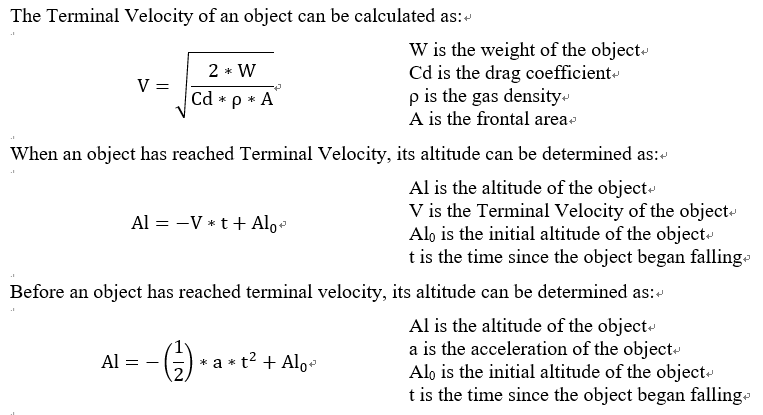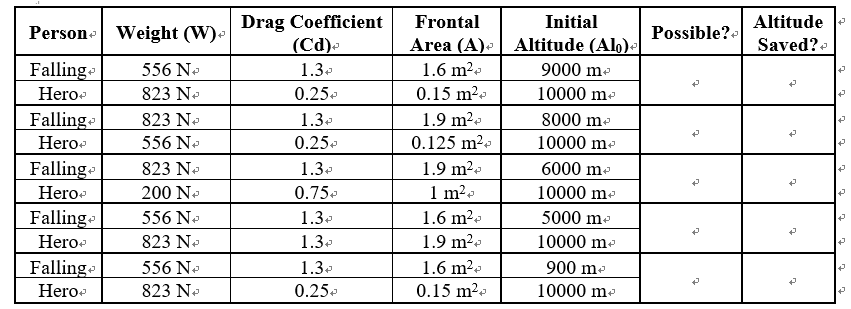Question
Write a MATLAB script or function that utilizes the Newton Raphson algorithm to determine whether the following situations are possible. Follow the steps outlined below

Write a MATLAB script or function that utilizes the Newton Raphson algorithm to determine whether the following situations are possible. Follow the steps outlined below to create your code.

1. Prompt the user for the weight, drag coefficient, frontal area, and initial altitude for both the original person and the hero.
2. Use the values to calculate the Terminal Velocities for both people (assume ? = 1.225 kg/m3).
3. Assuming that the first person has reached Terminal Velocity and the hero is able to accelerate at a constant rate of 9.8 m/s2, use the Newton Raphson method to determine the time at which the hero is able to catch the person falling from the plane. You should continue to update the time, t, using the Newton Raphson method until the absolute value of the difference of the two altitude equations is less than or equal to 0.001 seconds.
NOTES:
To aid in convergence, start with a guess of t =100 seconds.
Remember, if the derivative is at the estimate for t, you must adjust the estimate to avoid dividing by zero. Just add a small value (0.001) in this case.
4. Use the time determined in the previous step to calculate the final altitude and the final velocity of the hero ( ).
5. Determine whether the situation is possible by checking the following criteria:
A. If the altitude is positive and the final velocity of the hero is less than his/her Terminal Velocity, the hero is able to catch the person.
B. If the final altitude is negative, then it is not possible for the hero to catch the person.
C. If the final velocity of the hero is greater than his/her terminal velocity, check to see if it is possible for the hero to catch the person once he/she has reached Terminal Velocity as follows:
1),if the Terminal Velocity of the hero is less than the Terminal Velocity of the person, it is not possible for the hero to catch the person determine the time at which the hero reaches Terminal Velocity (V = a * t)
2).determine the altitude of both individuals at this point in time
3).solve for the time when the hero catches the person by using the first altitude equation for both people, using the altitudes found in the previous step for the initial altitude and solving for the time at which they are equal
NOTE: you do not need to use Newton Raphson for this
4).determine the altitude at which the hero catches the falling person; if the altitude is negative, it is not possible for the hero to catch the person; if the altitude is positive, it is possible for the her to catch the person
6. Display whether the hero saves the falling person or not as well as the altitude at which the person is saved.
Paste your MATLAB code below:
The Terminal Velocity of an object can be calculated as W is the weight of the object* Cd is the drag coefficient p is the gas density* A is the frontal area 2 W When an object has reached Terminal Velocity, its altitude can be determined as:* Al is the altitude of the object V is the Terminal Velocity of the object Alo is the initial altitude of the object- t is the time since the object began falling Before an object has reached terminal velocity, its altitude can be determined as: Al is the altitude of the object a is the acceleration of the obiect Alo is the initial altitude of the object- t is the time since the object began falling* The Terminal Velocity of an object can be calculated as W is the weight of the object* Cd is the drag coefficient p is the gas density* A is the frontal area 2 W When an object has reached Terminal Velocity, its altitude can be determined as:* Al is the altitude of the object V is the Terminal Velocity of the object Alo is the initial altitude of the object- t is the time since the object began falling Before an object has reached terminal velocity, its altitude can be determined as: Al is the altitude of the object a is the acceleration of the obiect Alo is the initial altitude of the object- t is the time since the object began falling*Step by Step Solution
There are 3 Steps involved in it
Step: 1

Get Instant Access to Expert-Tailored Solutions
See step-by-step solutions with expert insights and AI powered tools for academic success
Step: 2

Step: 3

Ace Your Homework with AI
Get the answers you need in no time with our AI-driven, step-by-step assistance
Get Started


